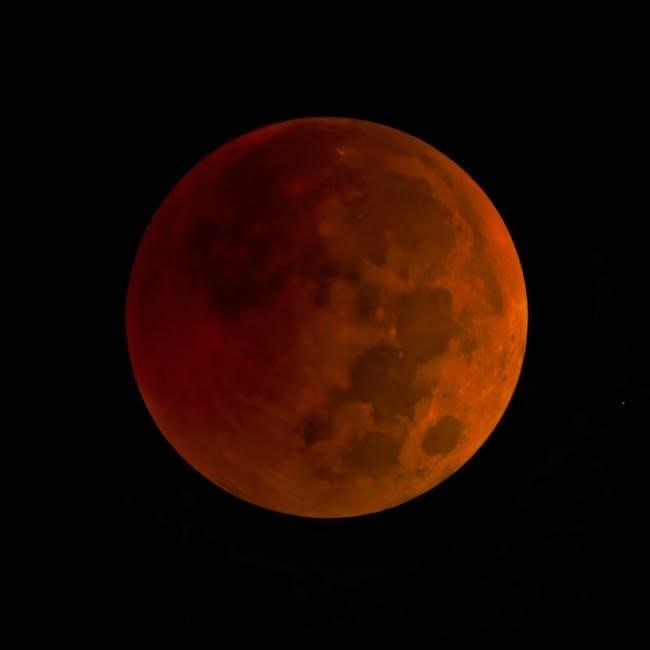The Red Moon, often called a Blood Moon, occurs during a total lunar eclipse when the Moon passes through Earth’s shadow, taking on a striking reddish hue due to scattered sunlight․
What is a Blood Moon?
A Blood Moon is a term used to describe the Moon’s reddish appearance during a total lunar eclipse․ This phenomenon occurs when the Earth is positioned directly between the Sun and the Moon, blocking direct sunlight from reaching the lunar surface․ Instead, the Moon reflects light that has passed through Earth’s atmosphere, scattering shorter blue wavelengths and allowing longer red wavelengths to dominate, creating the striking red hue․ The term “Blood Moon” is often associated with ancient myths and cultural significance, though it is purely a natural optical effect․ The intensity of the red color can vary depending on atmospheric conditions, such as dust and water vapor․ Despite its dramatic appearance, the Blood Moon is a temporary and harmless event, fascinating astronomers and sky gazers alike․
Key Facts About the Red Moon Phenomenon
The Red Moon phenomenon is a rare and awe-inspiring event, primarily occurring during a total lunar eclipse․ It is characterized by the Moon taking on a deep reddish hue, a result of Earth’s atmosphere scattering sunlight․ This phenomenon is not visible from all locations worldwide, as it depends on the alignment of the Sun, Earth, and Moon․ The Red Moon is often linked to cultural and historical significance, with various myths and legends surrounding its occurrence․ Scientifically, the red color varies in intensity based on atmospheric conditions, such as dust and water vapor․ The event is temporary, lasting only a few hours, and is completely safe to observe․ It offers a unique opportunity for astronomers and enthusiasts to study and appreciate the beauty of celestial mechanics․ Understanding the Red Moon enhances our appreciation for the complexities of our solar system․

The Science Behind the Red Moon
The Red Moon occurs when Earth’s atmosphere scatters sunlight onto the Moon during a total lunar eclipse, creating its distinctive red hue due to atmospheric conditions․
Why Does the Moon Turn Red During a Lunar Eclipse?
During a total lunar eclipse, the Moon turns red because Earth blocks direct sunlight, allowing only refracted light through its atmosphere to reach the Moon․ This light, which has longer wavelengths like red and orange, gives the Moon its reddish appearance․ The Earth’s atmosphere acts as a prism, scattering shorter blue wavelengths and letting red light pass through․ This phenomenon, known as Rayleigh scattering, is the same reason sunsets appear red․ The intensity of the red color can vary depending on atmospheric conditions, such as dust and water vapor, which can deepen or lighten the hue․ This unique event is both a scientific wonder and a breathtaking spectacle observed by people worldwide․

The Role of Earth’s Atmosphere in Creating the Red Hue
The Earth’s atmosphere plays a crucial role in creating the red hue of the Moon during a lunar eclipse․ When the Moon is in Earth’s shadow, the only light reaching it is refracted through the Earth’s atmosphere․ This light, which has longer wavelengths like red and orange, is scattered less by the atmosphere compared to shorter blue wavelengths․ The atmosphere acts like a prism, filtering out most of the blue light and allowing red light to dominate․ This phenomenon, known as Rayleigh scattering, is the same reason sunsets appear red․ Additionally, atmospheric conditions such as dust, water vapor, and pollutants can enhance or diminish the intensity of the red color, sometimes making the Moon appear more orange or brown․ Thus, the Earth’s atmosphere is essential in transforming the Moon’s appearance during a total lunar eclipse․

Observing the Red Moon
The Red Moon is best observed during total lunar eclipses, visible from Earth’s night side․ Optimal viewing occurs when the Moon is highest in the sky for clarity․
Best Times and Locations to Witness the Red Moon
The Red Moon is most visible during total lunar eclipses, which occur when the Earth, Moon, and Sun align, casting Earth’s shadow on the Moon․ These events are relatively rare, happening a few times a year, and are typically visible from specific regions depending on the Moon’s position․ The best viewing times are when the Moon is high in the sky, usually around midnight for many locations․ Regions with clear skies offer the optimal conditions to observe the reddish hue clearly․ Astronomical apps and resources can provide precise dates and locations for upcoming Red Moon events, helping enthusiasts plan their viewing experiences effectively․
How to Photograph the Red Moon Effectively
Capturing the Red Moon requires careful preparation and the right equipment․ Use a DSLR or mirrorless camera with a telephoto lens (at least 200mm) to ensure a clear and detailed shot․ A tripod is essential to stabilize the camera and avoid blur from hand movement․ Shoot in RAW format to preserve image details for better post-processing․ Manual mode allows adjusting ISO, aperture, and shutter speed․ Start with ISO 800-1600, an aperture of f/2․8 to f/5․6, and a shutter speed of 1/125s to 1/250s․ Focus manually on the Moon to ensure sharpness․ Bracket your shots to capture a range of exposures, which can later be merged for a balanced image․ Avoid using filters to prevent loss of the natural red hue․ Finally, edit the photos to enhance colors and contrast, ensuring the Red Moon’s unique appearance is vividly captured․

Cultural and Historical Significance
The Blood Moon has deep cultural and historical significance, often linked to myths, legends, and religious interpretations across ancient civilizations, symbolizing transformation and profound cosmic events․
Myths and Legends Surrounding the Blood Moon

Across various cultures, the Blood Moon has been shrouded in myths and legends․ Many ancient civilizations believed it signified ominous events or divine messages․ For instance, in some cultures, it was thought to signal the end of the world or a time of great upheaval․ In Norse mythology, the Blood Moon was associated with the wolves chasing the sun and moon, symbolizing chaos and destruction․ Similarly, in ancient China, a lunar eclipse was seen as a dragon swallowing the moon, requiring rituals to restore balance․ These myths often reflected humanity’s awe and fear of celestial phenomena, turning the Blood Moon into a symbol of mystery and transformation․
Modern Interpretations and Cultural Connections
In modern times, the Blood Moon has become a cultural and symbolic phenomenon, often celebrated and interpreted in various ways․ Many view it as a rare and awe-inspiring event, capturing its beauty through photography and social media․ Some cultures now associate it with festivals or spiritual practices, such as meditations or rituals to mark its occurrence․ In literature and art, the Blood Moon is frequently used as a metaphor for transformation, mystery, or dramatic change․ For instance, it is often linked to themes of renewal in astrology or as a symbol of resilience․ Additionally, the Blood Moon has inspired scientific curiosity, with researchers studying its optical properties to better understand Earth’s atmosphere․ This event continues to bridge ancient traditions and modern fascination, making it a shared experience across cultures and generations․

The Connection Between Lunar Eclipses and the Red Moon
A Red Moon occurs during a total lunar eclipse when Earth, Sun, and Moon align, casting Earth’s shadow on the Moon, which scatters sunlight to create the red appearance․
Types of Lunar Eclipses and Their Relation to the Red Moon
Lunar eclipses vary in type, with total, partial, and penumbral eclipses․ Only during a total lunar eclipse does the Moon fully enter Earth’s umbra, causing the dramatic red hue known as a Blood Moon․ This phenomenon occurs when all direct sunlight is blocked, and only refracted light passes through Earth’s atmosphere, scattering shorter wavelengths like blue and green, allowing longer red wavelengths to dominate․ Partial eclipses, where the Moon only partially enters the umbra, may show a subtle darkening but rarely display the intense red coloration․ Penumbral eclipses, involving only the Earth’s penumbra, result in a much fainter and less noticeable change in the Moon’s appearance․ Thus, the Red Moon is most closely associated with total lunar eclipses, where the alignment of celestial bodies creates the perfect conditions for this striking visual effect․
Why Total Lunar Eclipses Are More Likely to Produce a Red Moon
Total lunar eclipses are the primary events where the Moon turns red because they involve the Moon passing entirely through Earth’s umbra, the darkest part of its shadow․ During this alignment, direct sunlight is completely blocked, and the only light reaching the Moon is refracted through Earth’s atmosphere․ This process scatters shorter blue and green wavelengths, allowing longer red wavelengths to dominate, creating the reddish hue․ The intensity of the red color depends on atmospheric conditions, such as dust and water vapor, which can enhance or diminish the effect․ Partial eclipses, where the Moon only partially enters the umbra, rarely produce a noticeable red color, as some direct sunlight still illuminates the Moon․ Thus, total lunar eclipses provide the perfect conditions for the striking Red Moon phenomenon to occur․